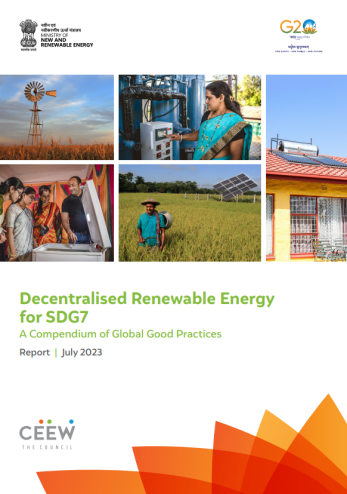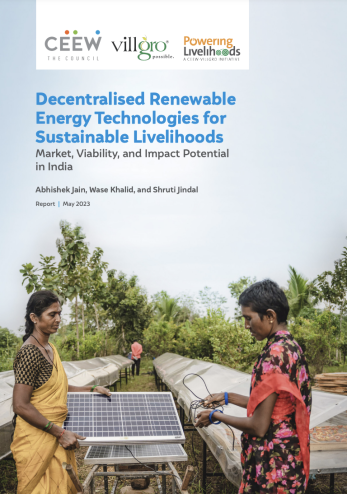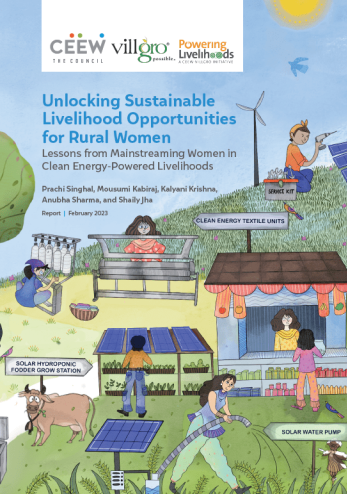Report
Powering Livelihoods Globally Through Clean Energy
Abhishek Jain, Arunabha Ghosh and Sanjana Chhabra
October 2021 | Sustainable Livelihoods
Suggested citation: Jain, Abhishek, Arunabha Ghosh, and Sanjana Chhabra. 2021. Powering Livelihoods Globally through Clean Energy. A GCF-CEEW Report. Stockholm: Global Challenges Foundation.
Overview
This study gives an overview of how Distributed Renewable Energy (DRE) is an effective and established solution for energy access. The study discusses the potential of DRE to power enterprises and support livelihoods across the developing world. It argues that the international community is yet to internalise the vital connections between global green energy transition, universal energy access and creating sustainable livelihoods on a bold new scale.
Key Findings
- Recent studies show that 770 million people still do not have access to electricity worldwide. Energy poverty remains one of the key barriers to sustainable development.
- In many underserved parts of the world, DRE systems can provide energy access at far lower costs than extending existing grids. DRE is an effective and established solution for energy access.
- DRE solutions benefited about 150 million people around the world in 2019 alone by providing new energy access.
- DRE sector is a significant employer in emerging economies and has positively impacted job creation in many countries. In Kenya, DRE systems have created 10,000 formal jobs (REN21, 2020). A 2017 survey of DRE companies in India revealed that the sector provided direct employment to about 309,000 people in formal and informal jobs.
- The market potential is in tens of billions. In India, there is an estimated USD 53 billion market in using clean energy for productive enterprises in rural areas such as cold storage, looms, rice mills, sewing machines amongst others.
- The potential of DRE for livelihood solutions remains unfulfilled. CEEW has analysed 36 programs globally that focus on DRE, out of which only three programs explicitly focus on promoting livelihoods (namely Powering Agriculture, Catalysing Agriculture by Scaling Energy Ecosystems (CASEE), and Powering Renewable Energy Opportunities (PREO)). Two of these three programmes are supported by a bilateral partnership of a donor and a philanthropy.
Key Recommendations
- Develop a multilateral and multi-stakeholder platform to drive large-scale adoption of productive uses of clean energy to stimulate jobs and growth in rural economies globally
- The platform proposed is envisioned as one in which the private sector takes the lead with support from civil society, philanthropy and DFIs, and buy-in from the public sector.
- The platform would be designed to solve specific barriers, which if removed can catalyse a DRE-based productive use market at scale.
- The platform should follow:
- Demand-centric, not supply-driven governance. The platform would extend bespoke technical assistance for demand-side ecosystem development converging skilling, financing and market linkage support for microenterprises across a range of high-priority countries.
- Catalyse innovation from labs to the market. By extending risk capital from strategic philanthropic organisations, the facility could de-risk early-stage technology and business model innovations, attracting more innovators and entrepreneurs to the sector.
- Solve for value not volume. The value-focused productive use market needs investors and financiers who are not looking at the scale in terms of volume alone. It needs investors who understand the impact and revenue metrics commensurate to a medium-scale enterprise.
- Enable partnership of equals by design. The facility and a national government could make an equal contribution to unlocking support. Such a structuring would ensure that the facility works in true partnership spirit with national participants, responding to their needs and aspirations.
- Leverage the power of the collective via pooled resources. The facility would ensure that knowledge sharing and feedback from stakeholders become key prerequisites to decision-making at various governance levels. The facility’s presence across geographies would help enable rapid knowledge sharing and a global body of evidence for the sector.
In India, there is an estimated USD 53 billion market in using clean energy for productive enterprises in rural areas such as cold storage, looms, rice mills, sewing machines and many others.






